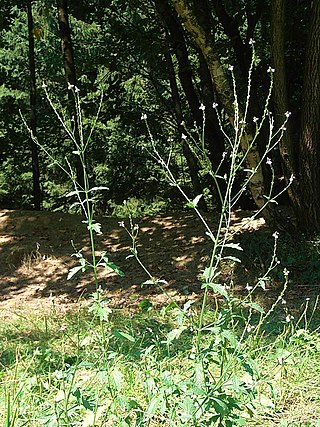
Verbena, also known as vervain or verveine, is a genus in the family Verbenaceae. It contains about 150 species of annual and perennial herbaceous or semi-woody flowering plants. The majority of the species are native to the Americas and Asia; however, Verbena officinalis, the common vervain or common verbena, is the type species and native to Europe.
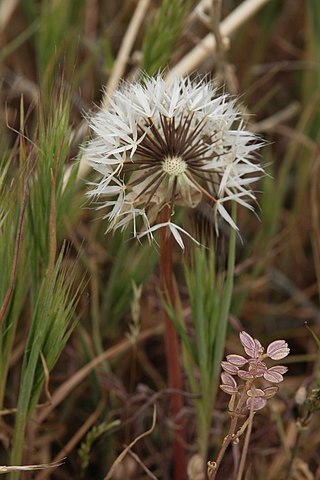
Uropappus, commonly called silverpuffs, is a genus of North American plants in the tribe Cichorieae within the family Asteraceae. Some authors accept only one species, U. lindleyi, and separate Stebbinsoseris.

Fragaria virginiana, known as Virginia strawberry, wild strawberry, common strawberry, or mountain strawberry, is a North American strawberry that grows across much of the United States and southern Canada. It is one of the two species of wild strawberry that were hybridized to create the modern domesticated garden strawberry.
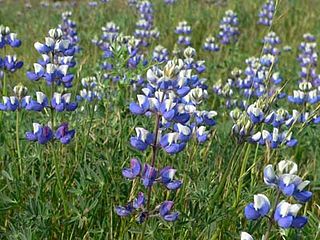
Lupinus nanus, the sky lupine, field lupine, dwarf lupin, ocean-blue lupine or Douglas' annual lupine, is a species of lupine native to the western United States. It is found natively in California, Nevada, and on Steens Mountain in eastern Oregon. It tends to grow on slopes and in open or disturbed areas below 1300 meters.
Coastal strand is a plant community of flowering plants that form along the shore in loose sand just above the high tide line.
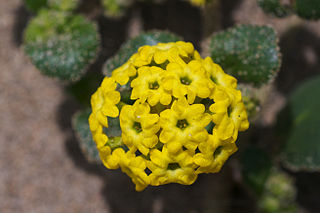
The perennial flower Abronia latifolia or Abronia arenaria is a species of sand-verbena known commonly as the coastal sand-verbena, or yellow sand-verbena. It is native to the west coast of North America, from southern California to southern British Columbia. In Canada, it is at risk of becoming extirpated, threatened, or endangered.

Verbena hastata, commonly known as American vervain, blue vervain, simpler's joy, or swamp verbena, is a perennial flowering plant in the vervain family Verbenaceae. It grows throughout the continental United States and in much of southern Canada.
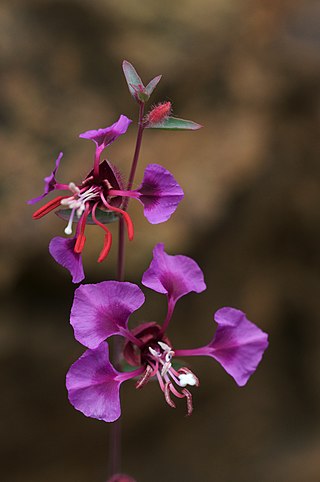
Clarkia unguiculata is a species of wildflower known by the common name elegant clarkia or mountain garland. The plant was named after Captain William Clark who was part of the Lewis and Clark Expedition.
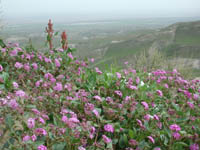
Abronia pogonantha is a species of flowering plant in the four o'clock family (Nyctaginaceae) known by the common name Mojave sand-verbena. It is native to California and Nevada, where it grows in the Mojave Desert, adjacent hills and mountains, and parts of the San Joaquin Valley in the Central Valley.

Mentzelia multiflora, commonly known as Adonis blazingstar, Adonis stickleaf, desert blazingstar, prairie stickleaf and manyflowered mentzelia is a herbaceous perennial wildflower of the family Loasaceae.
Tripterocalyx crux-maltae is a species of flowering plant in the four o'clock family known by the common names Lassen sandverbena and Kellogg's sand-verbena.
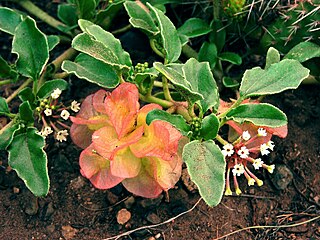
Tripterocalyx micranthus is a species of flowering plant in the four o'clock family known by the common names smallflower sandverbena and small-flowered sand-verbena.
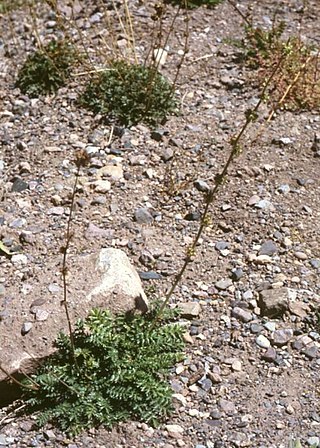
Acaena pinnatifida is a species of flowering plant in the family Rosaceae. It is known by the common names Argentinian biddy-biddy and California sheepbur. It grows in California, Argentina and Chile. The population from California is sometimes considered to be a distinct species or variety from the population in South America.

Abronia, the sand-verbenas or wild lantanas, is a genus of about 20 species of annual or perennial herbaceous plants in the family Nyctaginaceae. Despite the common names, they are not related to Verbena (vervains) or lantanas in the family Verbenaceae. They are closely allied with Tripterocalyx.
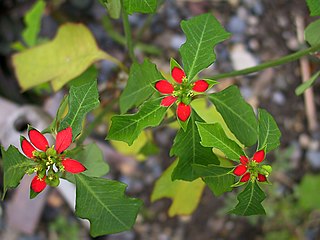
Euphorbia cyathophora, known by various names including painted spurge, dwarf poinsettia, fire-on-the-mountain, paintedleaf, and wild poinsettia. Native to subtropical and tropical North and South America, it is widely naturalized elsewhere. They belong to the Cyathium type of inflorescence. Here, the inflorescence axis is convex in shape. Dwarf poinsettia is an annual herb growing up to 3 feet tall. It has green stems with leaves that are oblanceolate with lobed margins. It grows near disturbed sites.

Plantago virginica, common names hoary plantain and Virginia plantain, is a species of plant native to North America and introduced in Asia. It is listed as a special concern in Connecticut. The Kiowa use it to make garlands or wreaths for old men to wear around their heads during ceremonial dances as a symbol of health. It is commonly found within the continental United States in the majority of states along coastal areas and on roads, though has become an invasive species to eastern China after its introduction c. 1980. It is an annual plant, blooming around the month of May.

Erythranthe arenaria, formerly Mimulus arenarius, also known as sand-loving monkeyflower, is a species of flowering plant. This plant is native to eastern California in the United States, where it is found in the central and southern Sierra Nevada mountains. Sand-loving monkeyflower is usually found in "sandy flats, sand bars, washes, seasonal creek beds" in the foothills and the High Sierra.
Verbena carnea, the Carolina false vervain, is a species of flowering plant in the family Verbenaceae. It is native to Texas and the southeastern United States. A short-lived perennial typically 2 ft (0.6 m) tall, it is found growing in lower but non-coastal areas such as sand hills, scrubby oak woodlands, and in longleaf pine woods.

Abronia nana, commonly known as the dwarf sand verbena, is a perennial herbaceous plant native to the arid regions of western North America, including parts of the Mojave Desert and Great Basin.
















